The Irish baler market is dominated by fixed-chamber machines, with variable-chamber machines only accounting for approximately 5% of new units retailed.
Why? Historically, this has been the trend as the rule of thumb is that fixed-chamber machines tend to handle silage and higher-moisture forages better than variable-chamber machines.
We caught up with John Hanifan from Mossie Hanifan and Sons, who have been running various brands of both fixed- and variable-chamber balers alongside one another for over three decades.
Today, the team runs a new McHale V6750 variable-chamber baler and a three-year-old McHale Fusion 3 Plus fixed-chamber machine. We travelled to Kildare to find out what their experience has been.

The V6 balers can make a bale from 0.6m (2ft) up to 1.68m (5ft 6in).
What’s the difference?
Well the pickup, rotor and knife bank (if fitted) tend to be the same. It is the chambers that are different. Fixed-chamber balers do exactly what the name suggests. They don’t have the ability to produce bales of different diameters to the same extent as a variable-chamber machine. The fixed-chamber balers we are accustomed to in Ireland are made up of a team of rollers which spin statically, pressurising the bale from the outside in. Meanwhile, a variable-chamber baler consists of moveable belts instead of rollers. These belts start off very close to the centre of the chamber, pressurising the bale from the centre out to the desired size. Fixed-chamber balers can only really make one size of a bale, usually a 1.23mx1.25m (4ftx4ft), while the McHale variable-chamber machine featured can make bales from 0.6m (2ft) up to 1.68m (5ft 6in).
When asked why they run both types of baler, John notes: “Both machines have a place in our fleet. Half our work is silage while the other half is hay and straw. If the weather allows, the variable chamber is only used for the hay and the straw while the fixed chamber Fusion is only used for silage.”

“We sell a lot of hay and straw and so do many of the customers we work for. We use the variable-chamber machine as it gives us total control of the size of the bale we produce. It allows us to make a nice dense bale, no matter what the diameter is. The belt baler makes the bale from the centre out, while the fixed chamber pressurises the bale from the outside in. This in turn means that the fixed chamber requires an extra layer of net, as there’s more of a risk of the bale swelling.”
“We have found that belt balers tend to have an increased output over fixed-chamber machines while working in straw, although they are quite similar in hay. With our older McHale V660 in heavy winter straw, I once turned out 124 bales in an hour. As the netting system and back door are typically slower on a fixed machine, output could be limited to 100 bales per hour in the same conditions.”
“I have also seen bales of straw become stuck inside fixed-chamber machines. When baling perfect straw and there’s a shine in the chamber, it can happen. On the flip side, some belt machines can’t handle higher moisture silage like the fixed chamber will. We’ve tried it before when the pressure has come on due to weather and found that the belts can cross. However, in saying that, we haven’t tried the new single-belt McHale baler in silage just yet. In our opinion over the years, a belt baler isn’t as suited to silage as a fixed-chamber machine.”
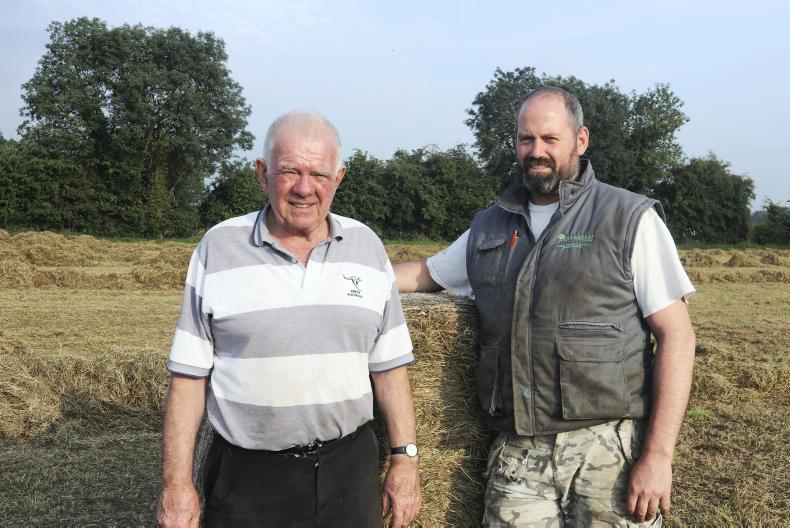
Mossie and John Hanifan
McHale V6750
First showcased at Agritechnica last autumn, the Hanifans were the first Irish customer to get their hands on one of the new McHale V6 round balers, namely the V6750.
The new V6 variable chamber range is made up of two models, the V6740 non-chopper and the V6750 chopper baler (15 knives offering a theoretical chop length of 65mm). John opted for the chopper version as he felt it would be worth more in terms of resale value when trading in again down the line.
The new range features redesigned panels with modernised livery. It now comes with the two pickup options, either a cam-operated pickup with five tine bars or a camless pickup with six tine bars (both 2.1m). It has a new adaptive intake, which allows the intake area to automatically adjust for light or heavy crops, helping to avoid peak loads.
McHale has increased the size of the crop augers which direct the crop flow into the rotor, in addition to increasing the rotor diameter. It is understood the angle at which the floor is positioned has also changed to aid crop flow. With just shy of 2,000 bales put through the baler, John has been very impressed with intake and crop flow, welcoming the addition of the crop press roller and the adaptive intake.
The main drive chain is protected by a slip clutch on the PTO. If a blockage occurs, the operator can hydraulically lower the floor from the cab. This widens the feed channel, and on re-engaging the PTO the blockage will be fed through. The floor can then be reset, and baling can resume.
The V6 balers can make a bale from 0.6m (2ft) up to 1.68m (5ft 6in). The bale size can be adjusted up from the minimum setting in increments of 20mm (3/4”). As standard, the V6 range is equipped with three heavy-duty endless belts while a single full-width endless belt is available as an optional extra.
“We opted for the full-width belt. We feel it’s the simplest option and also helps to reduce any crop loss. We’re a big fan of the McHale belts as it doesn’t have any joints. This was a problem with older John Deere belt balers we ran years ago,” explained John.
The V6750 features a simple netting system that comprises a moving roller which allows the roll of net to rotate as it is being applied. The net is stretched around the bale using a hydraulic brake. Net tension can be adjusted on the control console.
“I really like the simplicity of the netter on the McHale balers. There’s very little to go wrong. The new range can now carry three rolls as opposed to my older V660 which only carried two which is a welcome change,” added John.
The V6 range is fitted with a new style Expert Plus control monitor. From the monitor, the operator can adjust core size and bale size, core density and bale density, and the revolutions of net being applied.
The V6 features a new bale shape indicator which provides more accurate reading of the bale shape. This sensor detects the movement of the belt which indicates live information to the driver via the control console regarding which side of the chamber to fill. “I really like the bale shape indicator – when selling bales, presentation is very important. Overall, I like the control layout – it’s simple and effective. The only thing I would like to see added is a fully automated version,” concluded John.

The main drive chain is protected by a slip clutch on the PTO. If a blockage occurs, the operator can hydraulically lower the floor from the cab.
V6750 specs
Pickup: five tine-bars running on a cam trackKnives: 15 knifeBelts: one or threeNet capacity: three rolls (1 in use, 2 spare) Weight: 4,000kgWheel size: 500/50/22.5- standardMin hydraulic flow: 30l/min at 180 barList price: €56,761 plus VAT
John noted that he likes the simplicity of the auto-greasing system.
The Irish baler market is dominated by fixed-chamber machines, with variable-chamber machines only accounting for approximately 5% of new units retailed.
Why? Historically, this has been the trend as the rule of thumb is that fixed-chamber machines tend to handle silage and higher-moisture forages better than variable-chamber machines.
We caught up with John Hanifan from Mossie Hanifan and Sons, who have been running various brands of both fixed- and variable-chamber balers alongside one another for over three decades.
Today, the team runs a new McHale V6750 variable-chamber baler and a three-year-old McHale Fusion 3 Plus fixed-chamber machine. We travelled to Kildare to find out what their experience has been.

The V6 balers can make a bale from 0.6m (2ft) up to 1.68m (5ft 6in).
What’s the difference?
Well the pickup, rotor and knife bank (if fitted) tend to be the same. It is the chambers that are different. Fixed-chamber balers do exactly what the name suggests. They don’t have the ability to produce bales of different diameters to the same extent as a variable-chamber machine. The fixed-chamber balers we are accustomed to in Ireland are made up of a team of rollers which spin statically, pressurising the bale from the outside in. Meanwhile, a variable-chamber baler consists of moveable belts instead of rollers. These belts start off very close to the centre of the chamber, pressurising the bale from the centre out to the desired size. Fixed-chamber balers can only really make one size of a bale, usually a 1.23mx1.25m (4ftx4ft), while the McHale variable-chamber machine featured can make bales from 0.6m (2ft) up to 1.68m (5ft 6in).
When asked why they run both types of baler, John notes: “Both machines have a place in our fleet. Half our work is silage while the other half is hay and straw. If the weather allows, the variable chamber is only used for the hay and the straw while the fixed chamber Fusion is only used for silage.”

“We sell a lot of hay and straw and so do many of the customers we work for. We use the variable-chamber machine as it gives us total control of the size of the bale we produce. It allows us to make a nice dense bale, no matter what the diameter is. The belt baler makes the bale from the centre out, while the fixed chamber pressurises the bale from the outside in. This in turn means that the fixed chamber requires an extra layer of net, as there’s more of a risk of the bale swelling.”
“We have found that belt balers tend to have an increased output over fixed-chamber machines while working in straw, although they are quite similar in hay. With our older McHale V660 in heavy winter straw, I once turned out 124 bales in an hour. As the netting system and back door are typically slower on a fixed machine, output could be limited to 100 bales per hour in the same conditions.”
“I have also seen bales of straw become stuck inside fixed-chamber machines. When baling perfect straw and there’s a shine in the chamber, it can happen. On the flip side, some belt machines can’t handle higher moisture silage like the fixed chamber will. We’ve tried it before when the pressure has come on due to weather and found that the belts can cross. However, in saying that, we haven’t tried the new single-belt McHale baler in silage just yet. In our opinion over the years, a belt baler isn’t as suited to silage as a fixed-chamber machine.”

Mossie and John Hanifan
McHale V6750
First showcased at Agritechnica last autumn, the Hanifans were the first Irish customer to get their hands on one of the new McHale V6 round balers, namely the V6750.
The new V6 variable chamber range is made up of two models, the V6740 non-chopper and the V6750 chopper baler (15 knives offering a theoretical chop length of 65mm). John opted for the chopper version as he felt it would be worth more in terms of resale value when trading in again down the line.
The new range features redesigned panels with modernised livery. It now comes with the two pickup options, either a cam-operated pickup with five tine bars or a camless pickup with six tine bars (both 2.1m). It has a new adaptive intake, which allows the intake area to automatically adjust for light or heavy crops, helping to avoid peak loads.
McHale has increased the size of the crop augers which direct the crop flow into the rotor, in addition to increasing the rotor diameter. It is understood the angle at which the floor is positioned has also changed to aid crop flow. With just shy of 2,000 bales put through the baler, John has been very impressed with intake and crop flow, welcoming the addition of the crop press roller and the adaptive intake.
The main drive chain is protected by a slip clutch on the PTO. If a blockage occurs, the operator can hydraulically lower the floor from the cab. This widens the feed channel, and on re-engaging the PTO the blockage will be fed through. The floor can then be reset, and baling can resume.
The V6 balers can make a bale from 0.6m (2ft) up to 1.68m (5ft 6in). The bale size can be adjusted up from the minimum setting in increments of 20mm (3/4”). As standard, the V6 range is equipped with three heavy-duty endless belts while a single full-width endless belt is available as an optional extra.
“We opted for the full-width belt. We feel it’s the simplest option and also helps to reduce any crop loss. We’re a big fan of the McHale belts as it doesn’t have any joints. This was a problem with older John Deere belt balers we ran years ago,” explained John.
The V6750 features a simple netting system that comprises a moving roller which allows the roll of net to rotate as it is being applied. The net is stretched around the bale using a hydraulic brake. Net tension can be adjusted on the control console.
“I really like the simplicity of the netter on the McHale balers. There’s very little to go wrong. The new range can now carry three rolls as opposed to my older V660 which only carried two which is a welcome change,” added John.
The V6 range is fitted with a new style Expert Plus control monitor. From the monitor, the operator can adjust core size and bale size, core density and bale density, and the revolutions of net being applied.
The V6 features a new bale shape indicator which provides more accurate reading of the bale shape. This sensor detects the movement of the belt which indicates live information to the driver via the control console regarding which side of the chamber to fill. “I really like the bale shape indicator – when selling bales, presentation is very important. Overall, I like the control layout – it’s simple and effective. The only thing I would like to see added is a fully automated version,” concluded John.

The main drive chain is protected by a slip clutch on the PTO. If a blockage occurs, the operator can hydraulically lower the floor from the cab.
V6750 specs
Pickup: five tine-bars running on a cam trackKnives: 15 knifeBelts: one or threeNet capacity: three rolls (1 in use, 2 spare) Weight: 4,000kgWheel size: 500/50/22.5- standardMin hydraulic flow: 30l/min at 180 barList price: €56,761 plus VAT
John noted that he likes the simplicity of the auto-greasing system.








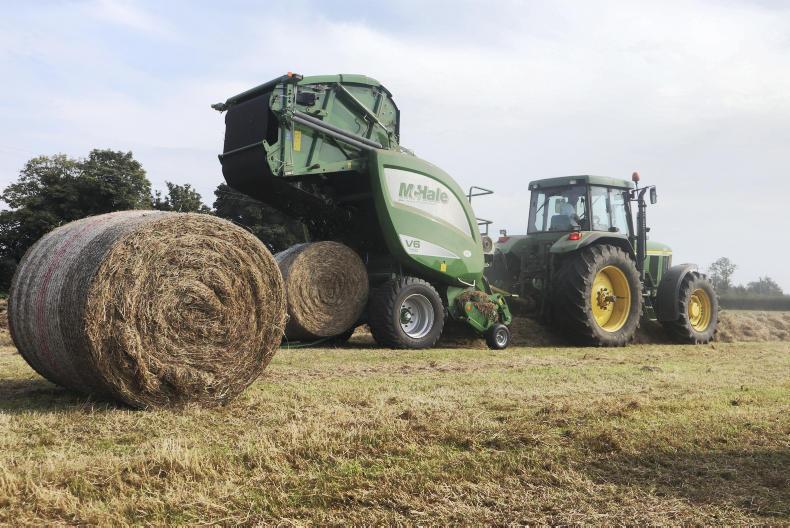

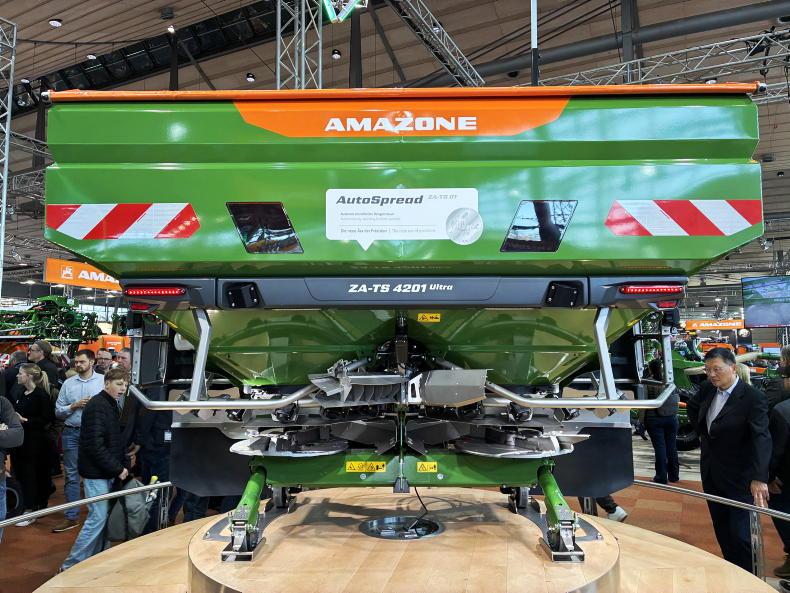

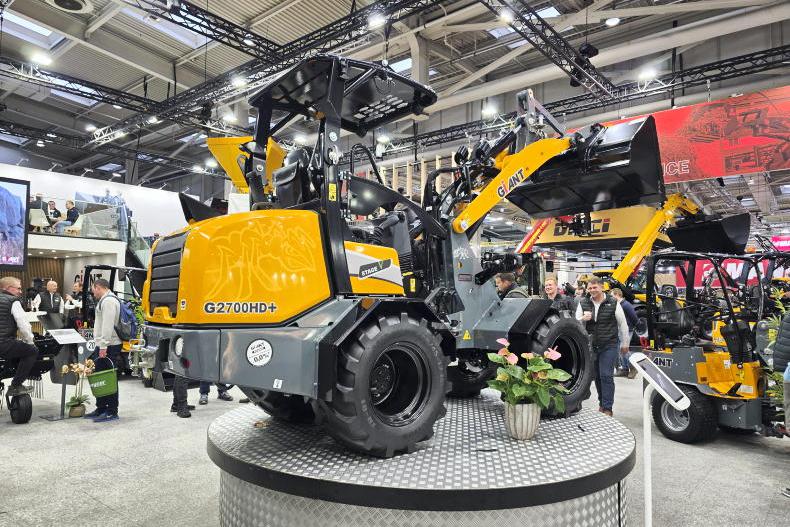
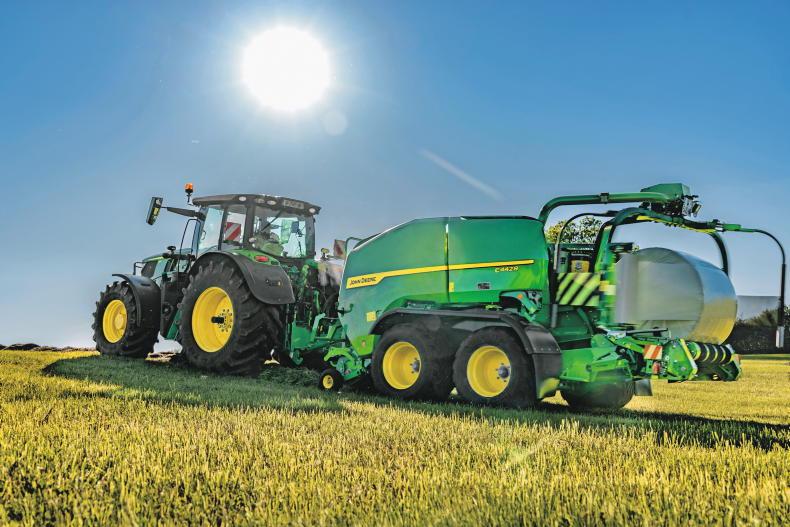
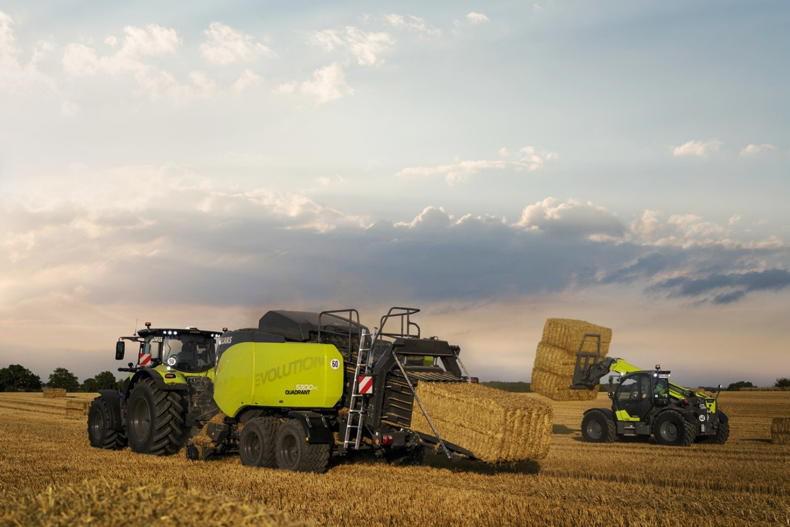
SHARING OPTIONS